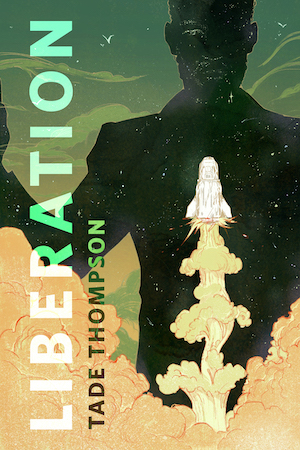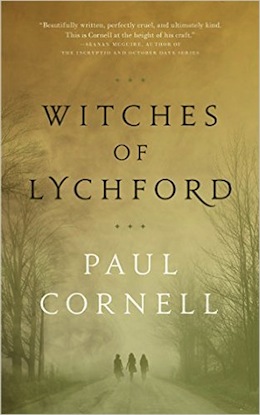Why is it so often three witches? That’s the number who band together to fight the forces of supernatural evil (in the form of a supermarket chain arriving in their small Cotswolds town) in Witches of Lychford, my forthcoming novella for Tor.com. That grouping is part of a long tradition.
The three witches of Macbeth are the obvious starting point. Shakespeare may have based those fate-deciding ‘weird sisters’ on the Fates—the Moirai of Greek myth or Parcae in the Roman version—of whom there were also three. (The historical chronicles he takes as his source material make this identification directly, making it clear that the term ‘weird sisters’ is another name for the Fates. It also offers the possibility they might have been fairies, but doesn’t actually call them witches.) The idea of the Fates may have influenced Norse belief in the Norns, also a trio of divine female arbiters of destiny.
The three witches have had a long career in literature and the media. The Witches of Eastwick, in both novel and movie form, puts the ages of the three witches on just about a level playing field, and, differing from most versions, has them specifically involved with Satan. Charmed was a long-running TV series that had its three witches as sisters, an oddly rare trope, considering Shakespeare. The Gargoyles animated series featured witches Luna, Phoebe, and Selene, a lunar motif I’ll look further into in a moment. The TV show Witches of East End takes that one step further, having, in Wendy Beauchamp, a fourth, dark side character, who complements the generational mix of the other three. (It’s interesting to note she isn’t from the novel on which the show is based, and was only added as a guest in the pilot episode.) At Vertigo, and in the wider DC Universe, Neil Gaiman made the classical three witches his Kindly Ones in the Sandman comic series. At Marvel, the youthful Witches Jennifer Kale, Satana and Topaz had their own title.
In pop music, from the Supremes to Bananarama to Destiny’s Child, one standard formation of the girl band is the triangle (even given said triangle’s tendency to put one member in front). The next workable number is five, which seems the minimum for boy bands, because nobody looks for three wizards. The girl bands have to work out for themselves the internal tensions of the mother, maiden, crone business. Consider, though, their hand gestures. We have imprinted in our minds the image of three women casting spells.
My own youthful readings in British folk religion told me that the three witches were the maiden, mother and crone, corresponding with the new, half and full moon, and that there was another, always hidden, figure, the moon in shadow. Three witches don’t make a coven: communities traditionally felt threatened by the imagined might of lots of witches. And if you want a villain, you really only want one, so in The Wizard of Oz the Wicked Witch of the West is immediately made a solo act, though the compass point Witches point again to the three plus one model. The three witches, on the other hand, always seem relatively positive. The original three gathered around their cauldron have become comedic, and modern versions of the three are out and out heroes. Perhaps their origins as Fates indicate a basic interface between the witches and humanity. These aren’t ‘the other’, the threatening darkness at the threshold, these are the witches we can talk to.
They’re also a female response to the Holy Trinity, three separate perceptions of one power. It’s when these groups work together that they display what Charmed called ‘the power of three’. A group of three women can vote quickly on the best way forward, and if they’re an inter-generational group they each bring different sorts of experience. The three witches represent a pretty ideal unit for challenging patriarchal power.
My own three manipulators of the numinous (not all of them see themselves as witches, indeed, one of them would be annoyed by the suggestion) are an elderly lady, Judith, and two estranged former friends of roughly similar age, Judith’s accidental apprentices, Lizzie and Autumn. The book is actually named after Autumn’s shop. These three are definitely on the positive side of the supernatural, protecting their town against the forces that have always been held back beyond its borders. Who’s more motherly and who’s more maidenly out of Lizzie and Autumn is an interesting question, one they’d probably have a long argument about. They’re absolutely part of their community, not exiled from it, and indeed, the civic life and hidden horrors of a small Cotswolds town are at the heart of what I wanted to do with the book, because myself and my family now live in such a place. I think the image of the three witches can be a comfortable vision, a domestic vision. How distant are those crones of Shakespeare’s from generations of women gathered around a cooking pot?
The mythic importance of the number three seems to go deeper than anything cultural. Babies are hardwired to look for the approach of three big circles, the mouth and eyes of their mother. Everything we’ve been talking about, and many other aspects of culture, from interior design to the alien abduction myth (Whitley Strieber’s visitors were always on about threes) might be based on the inner impact of those three circles. Three, as De La Soul said, really is the magic number.
Witches of Lychford is available on September 8th from Tor.com. Pre-order now for iBooks, Kindle, and Nook.
Read an excerpt here, and learn more about all our upcoming novellas in the Fall 2015 sampler!
Paul Cornell is a writer of science fiction and fantasy in prose, comics and TV, one of only two people to be Hugo Award-nominated for all three media. He’s written Doctor Who for the BBC, Action Comics for DC, and Wolverine for Marvel. He’s won the BSFA Award for his short fiction, an Eagle Award for his comics, and shares in a Writer’s Guild Award for his television.











Just as a datapoint, at Worldcon in Japan in 2007 I attended a panel discussing Terry Pratchett’s books. The panel and all bar 6 of the audience were Japanese. One of the points made was that the reason that Terry’s Witches books weren’t particularly popular in Japan was that the concept of witches coming in threes was alien to them. In their culture, witches always came in twos – one good one, one evil one, so the western mythos had no resonance for them.
At Vertigo, and in the wider DC Universe, Neil Gaiman made the classical three witches his Kindly Ones in the Sandman comic series.
The Kindly Ones (the Eumenides) are not original to Gaiman – they’re the alternative name for the Erinyes or Furies, the vengeance-demons of Greek mythology, of whom there were three: Alecto, Megaera and Tisiphone (Unceasing, Bitter and Vengeful Destruction).
And the Greeks were very keen on the three-woman team: not content with having three Fates and three Furies, they also had three Graces – Euphrosyne, Aglaia and Thalia (Brilliance, Bloom and Joy). The Romans reckoned there were nine (3 x 3) muses, though I can’t name them all offhand. Clio, Urania, Terpsichore, Erato, er… (googles) Polyhymnia, Calliope, Euterpe, another Thalia and Melpomene. (The Greeks thought there might have been only three – Practice, Memory and Song.)
And, beyond Greece and Rome, there were nine Valkyries – Brunnhilde and, er, the eight other ones that weren’t Brunnhilde – and three Rhine Maidens – Flosshilde, Weglinde and Wellgunde (I think?)
And there’s Charlie’s Angels, of course.
The generational explanation makes sense: you aren’t really going to have four generations of adults alive at once very often, so grandmother/mother/daughter.
I’m trying to think of some male equivalents – “mythical figures that come in groups”. Twins are quite common – Romulus/Remus, Castor/Pollux, Zetes/Calais. The twelve sons of Israel, the twelve disciples. And there are any number of fairy stories with three brothers going out to seek their fortunes…
I blame it all on Robert Graves, myself.
The lack of mention of Pratchett’s witches is startling here since he spent so many actual books exploring the meanings behind the need for three witches, and their relationships. Gaiman’s witches popped in a few times and moved things behind the scenes. Pratchett’s witches were protagonists, man.
Oh, and three Gorgons. Medusa and the two other ones. And three Graeae (the grey witches, with one eye between them, which they timeshared.)
Two characters tend to be static or working toward stasis in stories by either coming to terms with each other or one destroying the other.
Three characters, however, are always in motion in relationship to each other which makes for a more lively story.
From a Freudian psychological point of view, three is ego, superego, and id.
Or brain, heart, and body.
Or thesis, antithesis, and synthesis.
I first recognized the character trinity and its power in the original STAR TREK.
Kirk, Spock, and McCoy were an ideal heart, mind, and action/body trinity. When a problem needed to be solved, Spock was the logical mind, McCoy the emotional heart, and Kirk took both and created the ideal action.
These characters can also be considered a thesis, antithesis, and synthesis. Two opposite sides of a problem from Spock and McCoy, and Kirk pulling both together to find the solution.
Harry Potter, Hermione, and Ron are also a character trinity.
Three major characters like this can be a very powerful means of telling a story because they are not only working together but also working against each other. They can even reflect the complex nature of the book’s world or the moral dilemma of the story.
6: all true, but that isn’t true of any of the mythical three-woman groups, is it? There’s never any suggestion that eg Clotho and Atropos are getting on well but Atropos is suspicious of Lachesis. We never see very much at all of their within-group dynamics. They’re pretty much monolithic teams.
The Kindly Ones (the Eumenides) are not original to Gaiman
I don’t think Paul was suggesting Neil invented the Furies, just that he conflated them with the Fates (which I don’t think the Greeks did) and thereby with the maiden-mother-crone motif.
He also conflated them with Mildred, Mordred and Cynthia from 70s horror comic The Witching Hour, which I’m certain the Greeks didn’t do :).
There is a scene in Macbeth (though it’s often cut) with Hecate, the leader of the other three witches, so that would fit the “three-plus-one” form also.
Three is also a significant number because it represents the basic family unit: father, mother, child. Most of the ancient Egyptian cities were devoted to a central divine triad, such as Osiris, Isis and Horus at Abydos. Maybe the number seven is important because it also brings in the four grandparents?
@JeanTheSquare: The scene you’re referring to also has a second set of three witches accompanying Hecate. Shakespeare is almost certainly playing with mystical numbers here, because these extra witches don’t seem to have much to do except bump the numbers up to seven. Although, seeing as Hecate, queen of witches, was commonly described as ‘triple-bodied’ and seen as forming a trinity all in herself, you could also see the number of witches present as nine.
In the Wizard of Oz there were three witches. The one that Dorothy killed, the sister, and the good witch.
There were three witches in the Wizard of Oz
The one Dorothy killed, her sister and the good witch.